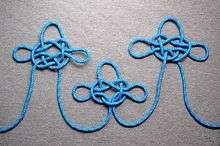Jury rigging
Jury rigging refers to makeshift repairs or temporary contrivances, made with only the tools and materials that happen to be on hand, originally a nautical term. On square-rigged sailing ships, a jury rig is a replacement mast and yards (a yard is a spar to which a sail is attached) improvised in case of damage or loss of the original mast.[1]
Etymology
The phrase "jury rigged" has been in use since at least 1788.[2] The adjectival use of "jury", in the sense of makeshift or temporary, has been said to date from at least 1616 when it supposedly appeared in John Smith's A Description of New England.[2] However, the word "jury" does not appear in the digital form of this document, as edited by Paul Royster of the University of Nebraska-Lincoln.[3] It appeared in Smith's more extensive The General History of Virginia, New-England, and the Summer Isles published in 1624.[4][5]
There are several theories about the origin of this usage of "jury":
- From the Latin adjutare ("to aid") via Old French ajurie ("help or relief").[6]
- A corruption of joury mast—i.e. a mast for the day, a temporary mast, being a spare used when the mast has been carried away. (From French jour, "a day".)[7]
- Contraction in the nautical tradition for injury
Rigging

Ships typically carried a number of spare parts (e.g., items such as topmasts), but the lower masts were too large to carry spares, at up to 1 meter (3 ft 3 in) in diameter. So a jury mast could be various things. Ships usually carried a variety of spare sails so rigging the jury mast, once erected, was mostly a matter of selecting appropriate size. Contemporary drawings and paintings show a wide variety of jury rigs, attesting to the creativity of sailors faced with the need to save their ships. Example jury-rig configurations are:
- A spare topmast
- The main boom of a brig
- To replace the foremast with the mizzenmast: mentioned in W. Brady's The Kedge Anchor (1852)
- The bowsprit set upright and tied to the stump of the original mast.
The jury mast knot is often mentioned as a method to provide the anchor points for securing makeshift stays and shrouds to the new mast. However, there is a lack of hard evidence regarding the knot's actual historical use.[8]
Although ships were observed to perform reasonably well under jury rig, the rig was quite a bit weaker than the original, and the ship's first priority was normally to steer for the nearest friendly port and get replacement masts.
Similar phrases

- The phrase "jerry-built" has a separate origin and implies shoddy workmanship not necessarily of a temporary nature.[1][9][10]
- Bricolage is building from what happens to be available.
- To "MacGyver" something is to rig up something in a hurry using materials at hand, from the title character of the American television show of the same name, who specialised in such improvisation stunts.
- In New Zealand, having a "Number 8 wire mentality" means to have the ability to make or repair something using any materials at hand (such as standard farm fencing wire).[11]
See also
References
- 1 2 Israel, Mark (29 September 1997). "jerry-built"/"jury-rigged". alt.usage.english Word Origins FAQ. Archived from the original on September 27, 2013. Retrieved 28 February 2013.
- 1 2 The Oxford English Dictionary, Volume V, H-K (Oxford: Clarendon Press, 1933; corrected reprinting 1966), 637.
- ↑ Captain and Admiral John Smith, and Paul Royster, ed., A Description of New England (1616): An Online Electronic Text Edition, Electronic Texts in American Studies. Paper 4. (Lincoln, NE: University of Nebraska-Lincoln, 1616;2013) University of Nebraska-Lincoln digital republication. ()
- ↑ Captaine Iohn Smith, The Generall Historie of Virginia, New-England, and the Summer Isles (London: Michael Sparkes, 1624; 2006 UNC digital republication), 223. (Online edition.)
- ↑ Note that in the orthography of Early Modern English 'I' was often used in place of 'J', thus the actual quote from Smith(1624) reads, "...we had re-accommodated a Iury-mast to returne for Plimoth..."
- ↑ Robert K. Barnhart, ed., Barnhart dictionary of etymology, (New York: H. W. Wilson Company, 1988), 560.
- ↑ E. Cobham Brewer 1810–1897. Dictionary of Phrase and Fable. 1898.
- ↑ Charles Hamel, "Investigations on the Jury Mast Knot" Accessed 2007-02-22.
- ↑ William and Mary Morris, Morris Dictionary of Words and Phrase Origins, 2nd Edition (New York: HarperCollins, 1988), 321-322.
- ↑ Wilton, Dave. "jerry-built / jury rig". wordorigins.org. wordorigins.org. Retrieved 28 February 2013.
- ↑ "Time to 'break free' of No 8 wire mentality". Stuff.
Further reading
- John Harland, Seamanship in the Age of Sail (Naval Institute Press, 1984)